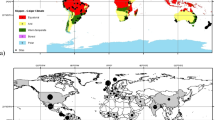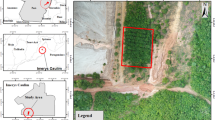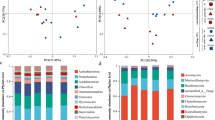Abstract
Soils were sampled at three different sites within the Paulshoek area of the Leliefontein District in Namaqualand, South Africa. At one site the effect of heavy grazing on soil characteristics under shrubs and from open positions was compared to a more lightly grazed area. At this site a diverse shrub community was mostly replaced by a single species, Galenia africana, when overgrazed. In another area the effects of cultivation on soil properties was investigated. At the third site the effect of Galenia shrub size on soil properties was measured.
Soils from the Paulshoek area of Namaqualand are generally infertile and very low in arbuscular mycorrhizal propagules. Patterns of nitrogen distribution at the landscape level are a result of nutrient enrichment associated with perennial shrubs. Arbuscular mycorrhizal infectivity, soil moisture and pH are also affected by shrubs. Only species capable of forming arbuscular mycorrhizas support populations of mycorrhizal propagules in their rhizosphere. Differences in plant available phosphorus under some shrubs indicate that processes associated with nutrient cycling are also affected by shrubs. Galenia tended to deplete soil moisture and increase soil pH more than other shrubs.
Small stock production results in a depletion of soil nutrients at the landscape scale since larger areas of low nutrient soil develop when shrub density decreases following heavy grazing. Heavy grazing also affects soil properties indirectly through a change in shrub composition. Cultivation resulted in a decrease in soil nitrogen and organic matter, a loss which was still detectable after 20 years of fallow. Zones of nutrient enrichment and higher pH were found where Galenia established in the old field. When soil was sampled under different size Galenia shrubs a positive correlation was found between shrub diameter and nitrogen, available phosphorus and pH indicating that Galenia was capable of establishing patches in the soil with different properties rather than selecting such areas for establishment. Thus, Galenia is able to maintain soil patterns typical of Succulent Karoo although it also establishes conditions which probably ensure its success. Individual shrub species also affect soil differently with respect to some components such as mycorrhizas.
Similar content being viewed by others
References
Abel, N. O. J. & Blaikie, P. 1989. Land degradation. Stocking rates and conservation policies for the communal rangelands of Botswana and Zimbabwe. Land Degradation & Rehab. 1: 101-123.
Allen, M. F. 1988. Re-establishment of VA mycorrhizas following severe disturbance: comparative patch dynamics of a shrub desert and a subalpine volcano. Proc. R. Soc. Edinburgh 94B: 63-71.
Allen, M. F. & MacMahon, J. A. 1985. Impact of disturbance on cold desert fungi: comparative microscale dispersion patterns. Pedobiologia 28: 215-224.
Allsopp, N. & Stock, W. D. 1993. Mycorrhizal status of plants growing in the Cape Floristic Region, South Africa. Bothalia 23: 91-104.
Allsopp, N. & Stock, W. D. 1994. VA mycorrhizal infection in relation to edaphic characteristics and disturbance regime in three lowland plant communities in the south-western Cape, South Africa. J. Ecol. 82: 271-279.
Arnold, T. H. & de Wet, B. C. 1993. Plants of southern Africa: names and distribution. Bot. Surv. Sth. Afr. Mem. 62. National Botanical Institute, Pretoria.
Behnke, R. H. & Scoones, I. 1993. Rethinking rangeland ecology: implications for rangeland management in Africa. Pp. 1-30. In: Behnke, R. H., Scoones, I. & Kerven, C. (eds), Range ecology at disequilibrium. Overseas Development Institute, London, UK.
Belsky, A. J. 1995. Spatial and temporal landscape patterns in arid and semi-arid African savannas. Pp. 31-55. In: Hansson, L., Fahrig, L. & Merriam, G. (eds.), Mosaic landscapes and ecological processes. Chapman & Hall, London.
Biot, Y. 1993. How long can high stocking densities be sustained? Pp. 153-172. In: Behnke, R. H., Scoones, I. & Kerven, C. (eds), Range ecology at disequilibrium. Overseas Development Institute, London, UK.
Bittrich, V. & Hartmann, H. 1988. The Aizoaceae-a new approach. Bot. J. Linn. Soc. 97: 239-254.
Burke, I. C., Reiners, W. A., Sturges, D. L. & Matson, P. A. 1987. Herbicide treatment effects on properties of mountain big sagebrush soils after fourteen years. Soil Sci. Soc. Am. J. 51: 1337-1343.
Charley, J. L. & Cowling, S. W. 1968. Changes in soil nutrient status resulting from overgrazing and their consequences in plant communities of semi-arid areas. Proc. Ecol. Soc. Austr. 3, 28-38.
Crawford, C. S. & Gosz, J. R. 1982. Desert ecosystems: their resources in space and time. Environ. Cons. 9: 181-195.
Dent, M. C., Lynch, S. D. & Schulze, R. E. 1989. Mapping mean annual and other rainfall statistics over Southern Africa. Water Research Commission, Pretoria, WRC Report, 109/1/89.
Dregne, H. E., Kassas, M. & Rozanov, B. 1990. A new assessment of the world status of desertification. Desert. Control Bull. 19: 6-18.
Ellis, J. E., Coughenour, M. B. & Swift, D. M. 1993. Climate variability, ecosystem stability, and the implications for range and livestock development. Pp. 31-41. In: Behnke, R. H., Scoones, I. & Kerven, C. (eds), Range ecology at disequilibrium. Overseas Development Institute, London, UK.
Ganade, G. & Brown, V. K. 1997. Effects of below-ground insects, mycorrhizal fungi and soil fertility on the establishment of Vicia in grassland communities. Oecologia 109: 374-381.
Halvorson, J. J., Bolton, H. & Smith, J. L. 1997. Patterns of soil variables related to Artemisia tridentata in a burned shrub-steppe site. Soil Sci. Soc. Am. J. 61: 287-294.
Hook, P. B., Burke, I. C. & Lauenroth, W. K. 1991. Heterogeneity of soil and plant N and C associated with individual plants and openings in North American shortgrass steppe. Plant Soil 138: 247-256.
Klopatek, J. M. & Stock, W. D. 1994. Partitioning of nutrients in Acanthosicyos horridus a keystone endemic species in the Namib Desert. J. Arid Environ. 26: 233-240.
Kormanik, P. P. & McGraw, A. C. 1982. Quantification of vesiculararbuscular mycorrhizae in plant roots. Pp. 37-46. In: N. C. Schenk (ed),Methods and Principles of Mycorrhizal research. The American Phytopathological Society, Minnesota, USA.
Milton, S. J. 1995. Spatial and temporal patterns in the emergence and survival of seedlings in arid Karoo shrubland. J. Appl. Ecol. 32: 145-156.
Milton, S. J., Yeaton, R. I., Dean, W. R. J. & Vlok, J. H. J. 1997. Succulent Karoo. Pp.131-166. In: Cowling, R. M., Richardson, D. M. & Pierce, S. M. (eds), Vegetation of Southern Africa. Cambridge University Press, Cambridge.
Murphy, J. & Riley, J. P. 1962. A modified single solution method for the determination of phosphate in natural waters. Anal. Chim. Acta 27: 31-36.
Noy-Meir, I. 1985. Desert ecosystem structure and function. Pp. 411-432. In: Evanari, M., Noy-Meir, I. & Goodall, D. (eds), Ecosystems of the world, Vol. 12A. Hot deserts and arid shrublands. Elsevier, Amsterdam.
Roos, P. C. & Allsopp, N. 1997. Soil nutrient ecology associated with Acacia sieberiana at different tree densities in a South African savanna. Afr. J. Range Forage Sci. 14: 39-44.
Ryel, R. J., Caldwell, M. M. & Manwaring, J. H. 1996. Temporal dynamics of soil spatial heterogeneity in sagebrush-wheatgrass steppe during a growing season. Plant Soil 184: 299-309.
Saggar, S., Hedley, M. J. & White, R. E. 1990. A simplified resin membrane technique for extracting phosphorus from soils. Fertilizer Res. 24: 173-180.
SAS 1994. SAS system for microsoft windows, release 6.10. SAS inst. Inc. Cary, NC, USA.
Schlesinger, W. H., Reynolds, J. F., Cunningham, G. L., Huenneke, L. F., Jarrell, W. M., Virginia, R. A. & Whitford, W. G. 1990. Biological feedbacks in global desertification. Science 247: 1043-1048.
Schlesinger, W. H., Raikes, J. A., Hartley, A. E. & Cross, A. F. 1996. On the spatial patterns of soil nutrients in desert ecosystems. Ecology 77: 362-374.
Stock, W. D., Dlamini, T. S. & Cowling, R. M. 1999. Plant-induced fertile islands as possible indicators of desertification in a succulent desert ecosystem in northern Namaqualand, South Africa. Plant Ecol. 142: 161-167 (this issue).
Tennant, D. 1975. A test of a modified line intersect method of estimating root length. J. Ecol. 63: 995-1001.
Todd, S. & Hoffman, M. T. 1999. A fence-line contrast reveals effects of heavy grazing on plant diversity and community composition in Namaqualand, South Africa. Plant Ecol 142: 169-178 (this issue).
Tongway, D. J. 1990. Soil and landscape processes in the restoration of rangelands. Aust. Rangeland J. 12: 54-57.
Tongway, D. 1994. Rangeland soil condition assessment manual. CSIRO, Canberra, Australia.
Tongway, D. J. & Ludwig, J. A. 1991. Small-scale resource heterogeneity in semi-arid landscapes. Pacific Conserv. Biol. 1: 201-208.
Tromble, J. M. 1988. Water interception by two arid land shrubs. J. Arid Environ. 15: 65-70.
Vinton, M. A. & Burke, I. C. 1995. Interactions between individual plant species and soil nutrient status in shortgrass steppe. Ecology 76: 1116B-1133.
Rights and permissions
About this article
Cite this article
Allsopp, N. Effects of grazing and cultivation on soil patterns and processes in the Paulshoek area of Namaqualand. Plant Ecology 142, 179–187 (1999). https://doi.org/10.1023/A:1009826412617
Issue Date:
DOI: https://doi.org/10.1023/A:1009826412617




